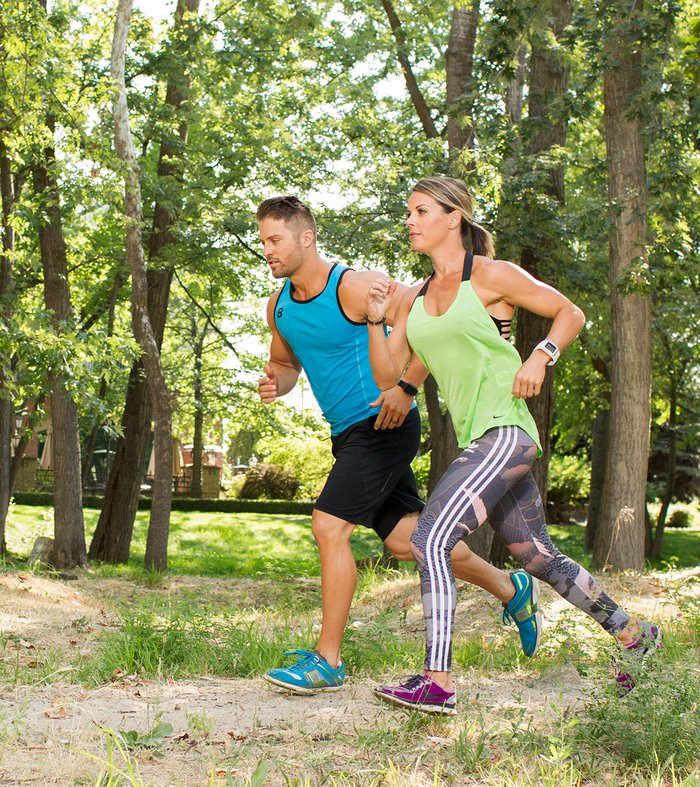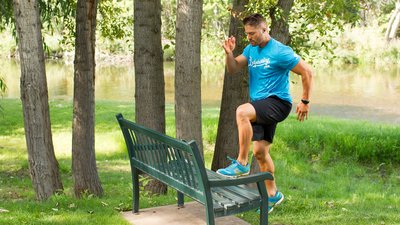Fitness al fresco can offer plenty of advantages. Don't miss out on better health just because you'd rather do squats than team sports. Here are some of the top benefits of taking your training from the gym to the park.
Take In The Fresh-Air Benefits
Whether you're sprinting up the bike path or doing bodyweight exercises at your neighborhood park, being outside has a ton of health benefits. Outdoor fitness increases your sun exposure, which ups your vitamin D levels. Vitamin D has been associated with more efficient metabolic function and endorphin production.
Increase Your Motivation To Train
Training outdoors has also been shown to help send your motivation levels soaring. Because the stimulus around you is always shifting, it keeps you focused by reducing fitness boredom—as anyone who's looked at the same gym walls all winter knows well, says Jeff Yellin, DPT, CSCS, regional director of Professional Physical Therapy for the boroughs of Long Island and Queens in New York City.

"There is only so long you can run in place, staring at whatever the gym has on TV," he says. "Outdoor workouts provide satisfaction with nice weather, plenty to see, and geographic landmarks to help keep you motivated. Most of all, it's likely that you'll enjoy your workout more. When that happens, you'll be much more apt to push yourself harder, try new exercise variations, and work out more often."
Burn More Calories
For those looking to burn calories, outdoor fitness is likely to get you to your goals faster, according to Jimmy Minardi, CPT, owner of Minardi Training on Long Island, New York. It's not just a walk in the park.
That's because being outdoors in the wind and on uneven ground creates additional resistance challenges that increase calorie burn. Your body works harder to maintain stability, recruiting more muscles for the effort.[1] That can keep a steady calorie burn going for 24-36 hours after a workout, depending on exercise intensity and type of training.
Temperature plays a part, too. When your body has to adjust to outdoor temps—whether hot or cold—your metabolism adjusts in order to compensate. That switch, although subtle, can burn more calories.
Equip Yourself
While you might not want to lug a bunch of weights and a squat rack to the park, you can duplicate a lot of weighted exercises with little or no equipment.
Tabata, EMOM (every minute on the minute), and other high-intensity techniques are good choices for outdoor workouts. Kym Nonstop's Home Body is a great home workout program that's well suited to being taken outside.
With a little creativity, you can thoroughly kick your own ass with just your body weight. Add a few strategic tools to ramp it up, and you can generate as much mass-building, calorie-torching power at the park as you would in the gym.
Bands: Don't underestimate the power of a big rubber band for outdoor sweat sessions. Fitness bands may look kinda goofy, but they can add serious resistance to kick your bodyweight routine into muscle-building territory.
A cool thing about fitness bands is their versatility. You can create a full-body routine with a huge variety of exercises and angles just by changing where you anchor the bands. Look around the park and you'll find lots of options: trees, fences, benches, and so on.
Kettlebells: Kettlebells are hands down the most portable way to create a completely brutal training experience. And there is plenty you can do with just one kettlebell. Pick a bell that's heavy enough to be a challenge but light enough to be used for a variety of exercises.
Yoga Mat: A yoga mat softens your landings on concrete and offers a clean, dry surface for doing floor work. Plus, you can use it as a makeshift picnic blanket, so keep one in your car all summer. It's not a bad idea to keep some sunscreen and an extra pair of shorts in there, too.
Be Careful, Though
One of the big differences between working out in a gym versus outdoor fitness is that the latter can be more unpredictable. While cool temperatures, uneven terrain, and sunshine can all provide benefits, they can also spring unwelcome surprises on the unprepared.
This seems like a no-brainer, but check the weather report ahead of time. If you live in Las Vegas and the temperature will hit 120 degrees F that afternoon, skip the 10-mile run.
Be flexible. If you can, schedule your outdoor fitness activities during the early morning in summer and in the afternoon during winter to take advantage of more comfortable temperatures.
And regardless of the weather, dress appropriately. Pro tip: Stock up on fitness gear at the end of the season, when sports and outdoor stores tend to have sales.
Hydrate in advance, especially on warm and sunny days. Even minor dehydration can lead to cramping and increased risk of muscle sprains and strains.
Finally, stay aware of your surroundings when you're outdoors. Make sure other people can use the park or bike path, too. If a little kid wants to monkey around on the bars where you're doing muscle-ups, check your ego and go do some dips on a park bench instead. Who knows—maybe someday that kid will be doing muscle-ups, too.
References
- Zamparo, P., Perini, R., Orizio, C., Sacher, M., & Ferretti, G. (1992). The energy cost of walking or running on sand. European Journal of Applied Physiology and Occupational Physiology, 65(2), 183-187.

